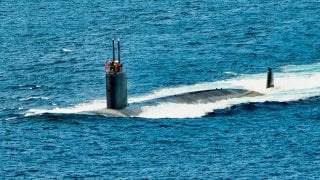The Navy’s SSN(X) Submarine, Explained
Some estimates say that the cost of each SSN(X) unit will be closer to $8 billion when all is said-and-done. The Virginia-class submarines that these boats are meant to replace come in at around $2.8 billion per unit, further underscoring the economic challenges the SSN(X) program faces. wünderwaffe
A recent Congressional Research Service (CRS) report highlights just how bad the United States Navy is doing in the shipbuilding department. According to the CRS report from August of this year, the Navy has admitted that it will be unable to have its first working SSN(X) submarine ready by the original target date of fiscal year 2035. Instead, it has been pushed back by five years to FY2040. In fact, Defense News indicates that the Navy is thinking that the SSN(X) will not be ready until the “early 2040s.”
In other words, the program that will cost a minimum of $6.2 billion per submarine will go over schedule (which likely means it will, therefore, go over budget as well). At the same time, that will place undue and unanticipated burdens on the existing U.S. Navy fleet of submarines, notably the Virginia-class submarines.
It’s ridiculous that the Navy is even building an entirely new class of submarines, especially considering that the Navy has yet to fully use its aging Los Angeles-class attack submarines, still has Virginia-class submarines in the hopper, and has a plethora of Ohio-class guided-missile submarines.
The problem is now that the Navy will have to extend the service lives of its submarines, notably the Virginia-class subs to make up for whatever difference the lack of available SSN(X) submarines poses to the fleet.
And let’s hope in this chaos that no great power conflict with China erupts, where American submarines will be the tip of that particular spear.
The shipyard crisis is America’s biggest threat
The biggest threat to the United States Navy, though, is not a near-peer competitor, like China. The threat that could most damage the Navy—even before a war erupts—is at home: America’s failing defense industrial base that cannot sustain the necessary shipbuilding and arms production for competing in a multipolar world of near-peer rivals.
In the case of the SSN(X) program, it is projected now to be significantly more expensive than its predecessors. Some estimates say that the cost of each SSN(X) unit will be closer to $8 billion when all is said and done. The Virginia-class submarines that these boats are meant to replace come in at around $2.8 billion per unit, further underscoring the economic challenges the SSN(X) program faces.
The construction of larger, more complex subs, such as the SSN(X), will likely exceed the capacity of current shipyards (unless radical modernization and changes are made to America’s defense industrial base). The Navy has a dual-yard construction strategy, which means that it assigns the construction of specific classes of ships to two different shipyards. It’s meant to increase efficiency and flexibility but ultimately has the opposite effect.
What’s more, there is an increasing human capital, or workforce, crisis in the Navy’s shipyards. Thus, the Navy’s ability to build ever more complex submarines in a timely fashion is diminishing as well.
Fighting tomorrow’s wars today?
Another issue facing the SSN(X) program is the incorporation of cutting-edge technologies. The Navy is trying to anticipate future wars and what they will require (which is rarely a smart move). This is how the Pentagon’s acquisitions processes have worked since the heady Cold War era. It’s downright irresponsible because no one can anticipate what a war forty years down the line will be like.
Just remember, the military that went to war against al Qaeda after 9/11 was the military that was designed to fight the Red Army for control over the Fulda Gap in Europe. It took years to adapt the force for low-intensity, long-duration combat. Similarly, no one in the Pentagon can possibly know what kind of environment the SSN(X) will enter if it leaves drydock in the 2040s.
And by trying to anticipate what tomorrow’s wars will be like today, the Navy is insisting that the SSN(X) be reliant on unproven and underdeveloped technologies. This could lead to serious operational vulnerabilities (if these systems do not perform as expected) as well as massive delays (if the systems do not mature concomitant with the new submarine platform’s very slow development).
Is the SSN(X) even necessary?
Then the Navy is adding even more complexity to the program by insisting that the SSN(X) be married with unmanned underwater vehicles (UUVs). While UUVs are undeniably the wave of the future (pun intended, given UUV swarming capabilities), combining them with submarines could reduce the SSN(X)’s stealth while underway and increase maintenance costs, since added complexity means longer repair times and higher costs.
With the rise of UUVs, the likelihood that the United States even needs the SSN(X), when it has a plethora of Los Angeles-class submarines as well as others at its disposal, is very low. Rather than blowing tens of billions of dollars on yet another wünderwaffe weapon, the Pentagon must instead get more realistic in its goals. It needs more moderately advanced submarines that can overwhelm enemy fleets, not fewer more advanced, expensive systems.
Quantity, after all, has a quality of its own.
About the author and expertise
Brandon J. Weichert, a National Interest national security analyst, is a former Congressional staffer and geopolitical analyst who is a contributor at The Washington Times, the Asia Times, and The-Pipeline. He is the author of Winning Space: How America Remains a Superpower, Biohacked: China’s Race to Control Life, and The Shadow War: Iran’s Quest for Supremacy. His next book, A Disaster of Our Own Making: How the West Lost Ukraine, is available for purchase wherever books are sold. Weichert can be followed via Twitter @WeTheBrandon.

